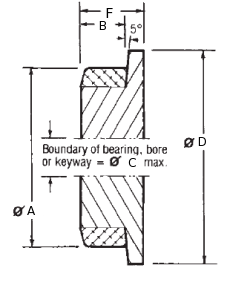
Standard wheel features flanges with a 5º angle and a ´flat tread´ (ie tread parallel
to the wheel axis) for running on flat top rail. Polyurethane is resilient, durable
material, resistant to abrasion and to many common chemicals. Polyurethane
tyred wheels are capable of carrying heavy loads and of transmitting driving
forces.
MATERIAL: Wheel Centre - Steel to BS970: Part 1: 1983: 080M40
Tyre - Polyester Based Polymer of 92º ± 3º Shore A Hardness
OPERATING TEMPERATURE RANGE:
-20ºC to +60ºC (115ºC for limited use)
PLEASE SPECIFY IF OPERATING IN HIGH HUMIDITY.
Anti-hydrolysis polyurethane is recommended for use in an operating
environment of high humidity.
Polyurethane to the above hardness used on these wheels is Vulkollan, a
high quality material that provides superior performance in most
applications.
Should the mechanical properties of Vulkollan be inappropriate for the
application, alternative grades of Polyurethane can be produced to meet
the requirements. Polyurethane can be bonded onto most metal centres
including aluminium, titanium, stainless steel and various ferrous and
non-ferrous alloys.
The ´Maximum Load Rating´ given for each wheel assumes the full tread width is in contact with the rail. In practice full contact with the rail
across the tread width is rarely achieved due to:-
a) Flange to rail clearance
b) Wheel Overhang
c) Rail Corner Radii
For calculation of the ´Maximum Allowable Load´ see
´Design Data´ para. 5.1.
In addition the ´Maximum Load Rating´ given for each wheel is for operation under ideal conditions.
Load factors must be applied according to the anticipated working conditions - see
´Design Data´ para. 4.1.
Alternative Bore/Bearing diameters and alternative bearing types (i.e) bronze brushes, self lubricating brushes,
etc.) are available to order -
see
´Design Data´ para. 6.0. |



